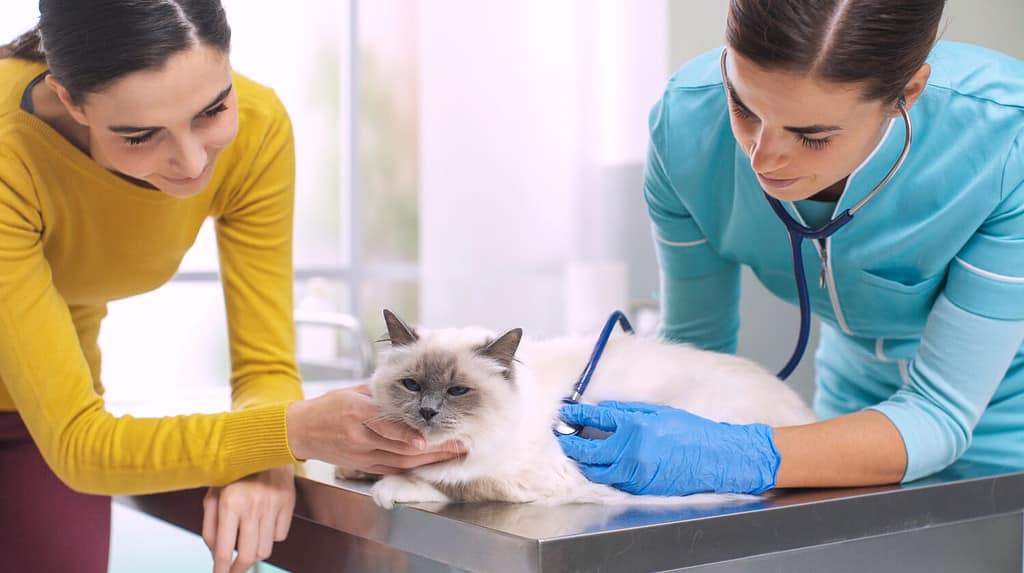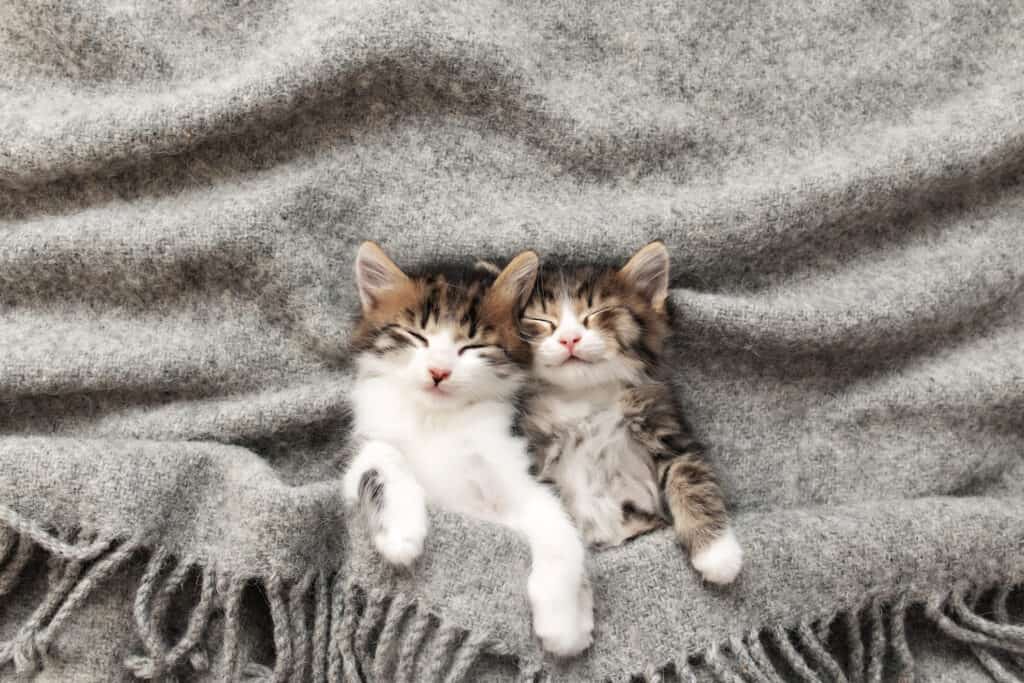
Cats should only receive medication, including trazodone, as prescribed by a veterinarian.
©Stock-Asso/Shutterstock.com
Trazodone treats depression in humans. This medication belongs to a class of drugs called serotonin antagonist and reuptake inhibitors (SSRIs). This medication works by turning off certain receptors in the body and raising the levels of serotonin and norepinephrine. These two chemicals serve to improve a person’s mood. However, this medication also acts a sedative, especially in dogs and cats. Though more often used for dogs, cats can take trazodone, too. Let’s learn more about using trazodone for cats!
What is Trazodone Used for in Cats?
Generally, trazodone is safe for cats. Many veterinarians use this medication to help cats relax on long car trips. They also prescribe it to cats that display fractious behavior during medical appointments. Fractious means, by definition, quarrelsome or irritable. In the veterinary world, this term describes a pet which is aggressive and uncooperative for examinations and procedures. Sometimes, a dose of trazodone two hours before a visit to the vet helps the cat be more patient with the doctors and staff. This makes the visit less stressful for everyone involved, including the owner!
The American Veterinary Medical Association (AVMA) even published a study regarding the usefulness of trazodone in cats for traveling and vet visits. They determined that a single dose prior to these events resulted in fewer signs of stress in cats and was well-tolerated.
Post-Surgery Sedation
Another common use for trazodone in cats is for post-surgery sedation. Most of the time when surgery is performed on a pet, recovery requires a certain period of restricted activity. This means no running and playing rough, no jumping on and off the couch, and no zoomies at 4 am around the house. How does one keep a cat from doing these things? You can’t simply tell your cat no or put them in a kennel like a dog. So, some veterinarians reach for trazodone to help keep cats calm after these types of procedures.
Trazodone May Not Work For Your Cat
Unfortunately, trazodone doesn’t work for all cats. You see, cats and dogs both produce incredible amounts of adrenaline when placed into stressful situations. Adrenaline in both humans and animals increases breathing rate, heart rate, blood circulation, and the metabolism of carbohydrates. Basically, it gives the body a boost of energy so it can be ready to fight or take flight (run away). This adrenaline often overrides any sedative they are given. Occasionally, trazodone and medications like it cause the opposite effect and make the cat more irritated and reactive. In such cases, injectable sedatives may be required.

Some cats who display fractious behavior at the vet may be soothed with trazodone.
©Anna Krivitskaya/Shutterstock.com
Side Effects and Trazodone Overdose in Cats
The use of any medication comes with the risk of side effects. If you think your cat may have accidentally ingested trazodone or you may have given too much, contact the Pet Poison Helpline immediately and take your cat to the nearest emergency veterinary hospital.
Trazodone has been extensively studied in dogs with only about 20% of dogs experiencing negative side effects. That’s a great record! However, it hasn’t been as closely surveyed in cats. Despite this fact, trazodone is considered safe for most cats.
The most concerning side effects of trazodone in cats:
- Serotonin syndrome: This condition is a potential side effect of any SSRI drug. This condition happens when too much serotonin is released into the bloodstream. Although this condition is rare, it is important to know the signs before giving your cat trazodone. Serotonin syndrome becomes more likely when SSRI drugs are used together. We’ll discuss this a bit later.
Serotonin syndrome symptoms include increased heart rate, tremors/shaking, wide pupils, increased breathing rate or trouble breathing, fever, and high blood pressure. Certain medications can help reduce serotonin levels and return your cat to normal. Immediate treatment is necessary. - Low blood pressure: Trazodone can lower blood pressure in cats especially when combined with other medications intended to do this. When blood pressure drops too low, you will notice the cat becomes very lethargic and possibly unable to move. They will likely have pale gums and might feel cold to the touch. When blood pressure is low, the heart tends to beat harder and faster to compensate. This potentially deadly side effect requires quick treatment.
Other Side Effects of Trazodone in Cats
Thankfully, the most common side effect of trazodone in healthy cats is nausea. Giving the medication along with a meal usually reduces this effect. Another side effect is excessive sleepiness which usually wears off after a few hours.
Contact your veterinarian immediately if you notice any of these signs. While they may not be related to trazodone ingestion and the symptoms may seem mild at first, early detection can save your cat’s life!

Trazodone can cause excessive sleepiness in cats.
©iStock.com/Olena Ivanova
When Should Cats Not Take Trazodone?
We’ve already learned that cats should only take trazodone when specifically prescribed by a veterinarian. However, there are some medications and other conditions that may prevent a veterinarian from using it. Dr. Julie Parks, a veterinarian at Northwood Hills Animal Hospital in Gulfport, MS told AZ Animals, “I wouldn’t give trazodone if the cat is on other medications that affect serotonin or affect brain activity, like seizure medication.” She went on to include several medications to avoid.
Medications Your Cat Should Not Take With Trazodone
This list shows medications your cat should not take while taking trazodone unless specifically directed to do so by your veterinarian.
- Other SSRI medications such as fluoxetine, buspirone, alprazolam, etc. can increase the risk of serotonin syndrome.
- Seizure medications such as phenobarbital, levetiracetam, zonisamide, etc. Because these medications affect brain activity, avoid trazodone (per Dr. Parks).
- MAOI medications such as selegiline and amitraz can increase the risk of serotonin syndrome.
- Some anti-nausea medications such metoclopramide can increase the risk of serotonin syndrome.
- Other sedatives such as tramadol can increase the risk of serotonin syndrome.
- Gabapentin, which treats nerve pain in humans, is sometimes used in cats for sedation. Combining these can result in over-sedation.
- Phenothiazines such as acepromazine can increase blood levels of trazodone therefore increasing the risk of serotonin syndrome.
- NSAIDS such as meloxicam, aspirin, and robenacoxib increase the risk of bleeding when combined with trazodone.
- Macrolide antibiotics such as azithromycin and erythromycin can increase the risk of serotonin syndrome.
- “-azole” antifungal drugs such as ketoconazole and metronidazole can increase the risk of serotonin syndrome.
Conditions That Prevent Your Cat From Taking Trazodone
Some conditions your cat may have could also prevent them from taking trazodone. This includes seizure disorders, high or low blood pressure, heart failure, liver failure, and kidney failure. Like most drugs, trazodone passes through the liver and kidneys. If these are already failing, it’s best not to push them too hard. In the case of heart failure, the chance of blood pressure increasing/decreasing and making the heart work harder is too great. As stated before, trazodone affects brain activity so giving it to cats with seizure disorders can be harmful.
Dosage Chart for Trazodone in Cats
Always follow your veterinarian’s instructions for medication exactly. Most veterinarians recommend trying trazodone for your cat at home before they encounter a stressful event. This will help you and your veterinarian determine the minimum effective dose (MED) for your cat. MED means using the smallest dose possible to achieve the desired outcome. In the case of trazodone, that’s usually a happy cat that’s not seeking to harm. Using the MED for your cat can help prevent overdosing along with protecting your cat’s vital organs.
Generally, the dose for trazodone in cats ranges from 3.5 to 6.9 mg per pound. See the chart below for generalized dosing information. Most cats use it only when necessary for stressful events, but you can give it up to every 12 hours.
Note that trazodone most often comes in 50 mg, 100 mg, 150 mg, and 300 mg tablets. Cutting the tablets to equal the correct dose needed is acceptable. If your cat cannot take tablets, your veterinarian might to arrange for compounded medication in a liquid or treat.
| Cat’s Weight in Pounds | Trazodone Dosage | Cat Breeds Include |
|---|---|---|
| 0-5 | 3.5-34.5 mg per dose | Singapura, Bambino |
| 6-10 | 21-69 mg per dose | Siamese, Cornish Rex |
| 11-20 | 38.5-138 mg per dose | Bengal, Ragdoll |
| Over 20 | consult your vet | Maine Coon, Savannah |
Alternatives to Trazodone for Cats
Cats are tricky creatures. They tend to be very independent and sometimes, that makes it difficult for you and your veterinarian to work with them. If you’re not ready to jump to medication for your cat, consider these alternatives. Always consult your veterinarian before starting any medication or supplements.
Calming Treats
A wide variety of calming treats exist on the pet care market today. Generally safe for your cat, asking your veterinarian about which to choose is wise. You may have to try a few different ones before finding one that your cats likes and tolerates that also gives you the desired effect. Nutramax and Pet Honesty both make highly-rated calming treats available on Chewy.
Pheromones
Pheromones are chemical secretions that trigger a response in members of the same species. For instance, when a male lion sprays to mark his territory, he is also sending out pheromones to attract a female mate. Products such as Feliway® use these pheromones to help cats feel more at ease. It comes in sprays that you can use in your cat’s carrier about 15 minutes before putting them in. They also make collars for cats who need more constant calming aids. The Journal of Feline Medicine and Surgery published an article confirming the effectiveness of pheromones in combating aggression between cats in the same household. This remedy helps many cats with their anxiety without the use of drugs like trazodone.
Final Thoughts on Trazodone for Cats
If your cat experiences anxiety and stress when travelling, at the vet, or even during thunderstorms, ask your veterinarian about trying trazodone for them. This medication is a great tool and when used properly can help relieve your cat’s stress and yours!
As always, if you’re concerned about your pet for any reason, please take them to the veterinarian! Many human medications are not safe for pets and can result in the loss of your pet. Your veterinarian is the best person to work with you and your pet to figure out what medications are best for them.
The photo featured at the top of this post is © Anastasia Tveretinova/Shutterstock.com
Thank you for reading! Have some feedback for us? Contact the AZ Animals editorial team.






